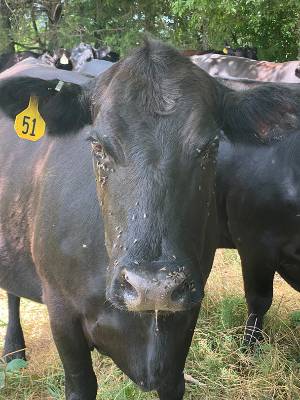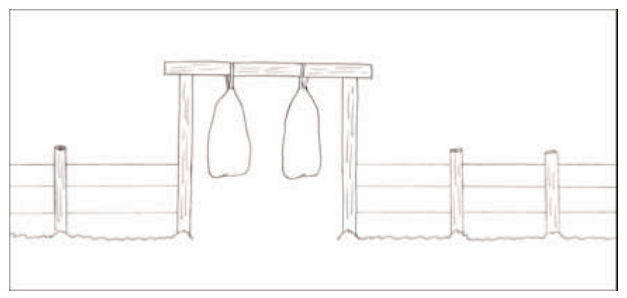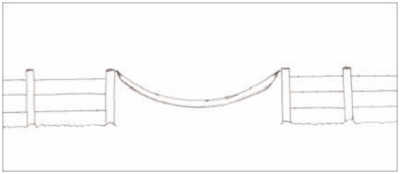Kelly Loftin
Extension Entomologist
Controlling face flies on cattle

What are face flies?
Face flies became common in Arkansas during the late 70’s and early 80’s after their
accidental introduction into North America in the 1950’s. Face flies tend to be a
bigger issue for cattle producers in the northern half of Arkansas. Although this
pest fly does not reach pest status every ear like the horn fly, it will be observed
almost every year in north Arkansas. Populations peak in June and often again in late
August.
What problems do face flies cause?
Economic losses related to face flies include reduced weight gain and milk production
as well as their potential role in pinkeye. Face flies are mechanical vectors of Moraxella
bovis, a bacterium responsible for infectious bovine keratoconjunctivitis (IBK or
pinkeye). Thelazia spp., a nematode eye worm, can be transmitted
to horses and cattle by infective face flies. In addition, to being an important livestock
pest, face flies can become a significant nuisance to a homeowner if they overwinter
indoors.
Biology of face flies
The face fly is not a blood feeder like the horn fly; instead, it feeds on the secretions around the eyes, nostrils or on wounds of animals. Only female face flies feed on the animal; while males feed on nectar. Face flies are intermittent feeders spending a limited amount of time feeding on the animal. Most of their time is spent resting in vegetation or on fences.
Female face flies will only lay eggs in fresh bovine manure that is less than 10 minutes old. Eggs hatch into maggots which continue to develop until they reach the pupal stage. Mature maggots pupate in the soil under and around the manure pat. The lifecycle from eggs to adults takes from two to three weeks. Face flies diapause (overwinter) as adults in protected areas such as barns, attics, uninsulated walls, etc. and emerge in the spring.
How to control face flies
Face flies should be controlled on cattle before they reach more than 10 per head.
On cattle they are difficult to control for a couple of reasons:
1) flies feed on the face which is difficult to treat and
2) they spend a significant time off the host.
Self-treatment options for face flies
Daily insecticide treatment maximizes control. For this reason, self-application devices
such as
dust bags and back rubber equipped with face flips or specific insecticide impregnated
ear tags are generally more effective. Both cattle and calves should be treated.
Forced-use dust bags

Self-treatment devices should be placed in such a manner that cattle are forced to use the device daily. This is easily accomplished by restricting access to water or mineral which requires cattle to pass through the device daily. Dust bags should be hung in pairs at a height and spacing that results in application to the face (for face flies) and back (for horn flies). Active ingredients used in dust bags include: coumaphos, tetrachlorvinphos, permethrin and zeta-cypermethrin. Inspect dust bags regularly and recharge with insecticide dust when needed. Dust bags should be kept dry to reduce insecticide clumping and loss of effectiveness.

is applied to the animal as it rubs under the device when passing through a gateway (see illustration above).
Insecticide-charged back rubbers
Back-rubbers charged with an insecticide and fuel or mineral oil mixture and equipped with face flips (burlap or canvas cloth strips affixed around the back-rubber) is a good treatment option for face flies (and also controls horn flies). Active ingredients used in backrubbers include coumaphos, phosmet, tetrachlorvinpho/dichlorvos combination, permethrin and permethrin/piperonyl butoxide combinations.
Pour-on treatments to control face flies
Pour-on insecticides are ready-to-use formulations applied along the back line of cattle at a dose based on body weight. The concentration of the insecticide in a pour-on is usually higher than the final concentration used in a spray solution (see below). Rates vary depending upon the insecticide formulation but usually range from 0.5 to 2 ounces per animal.
Most conventional pouron insecticides used against face flies are formulated from synthetic pyrethroids. However, a few pour-on insecticides, macrocyclic lactones (ivermectin, etc.), are formulated to control internal parasites as well. Reliance on pour-on macrocyclic lactones alone for face fly control should be limited to lessen internal parasite tolerance issues. Pour-on insecticides will normally provide control from 2 to 4 weeks following application. Consult MP144, Insecticide Recommendations for Arkansas, for additional information on pour-on insecticides.
Specific pour-on insecticides that allow treatment of the face will provide face fly
control but may not provide enough residual activity to maintain low face fly numbers
between the minimum application frequencies. Pour-on insecticides that allow application
to the face include specific pyrethroids such as Ultra Boss®, Permectrin®
CDS and CyLence®.
Ear tag treatments
Not all insecticidal ear tags are equal in controlling face flies. Some are effective while others only provide some reduction. Ear tags such as Corathon®, CyGyard®, CyLence® Ultra, GardStar® Plus, Python® and Saber® Extra provide reasonable face fly control. Apply two tags per animal; one in each ear.
Spray treatments
High volume, high-pressure residual insecticide spraying is effective in controlling face flies and other cattle pests. About 1 to 2 quarts of an insecticide solution is applied with a power sprayer at a pressure of 150 200 psi. This amount and pressure will provide near complete coverage and penetration to the animal’s skin. One drawback to high pressure spraying is the increased cattle handling required to make multiple applications throughout the fly season.
Low pressure, low-volume spraying with handheld sprayers can be effective for some producers with gentle animals. With low-pressure, low-volume spraying, the applicator walks or drives around cattle applying an insecticide solution on an as-needed basis. Insecticide concentrates labeled to mix with water and apply to cattle primarily include the synthetic pyrethroid, organophosphate and spinosyn classes.
Insecticide spray formulations are effective in controlling face flies when directed
toward the face. However, they may not provide the residual activity necessary to
provide control between the minimum spray frequencies. Insect growth regulators such
as methoprene or diflubenzuron applied to feed or minerals and fed to cattle reduce
larval development but are not designed to kill adult flies. In circumstances
where cattle herds are somewhat isolated from untreated herds and sufficient consumption
by the animals can be maintained, IGR feed-through insecticides can be effective against
both horn and face flies.
Always read and follow directions on the insecticide label. A listing of insecticides
uses to control face flies and other pests of cattle and horses is available in the
Insecticide Recommendations for
Arkansas.